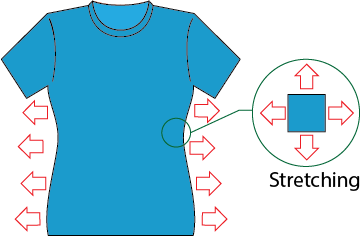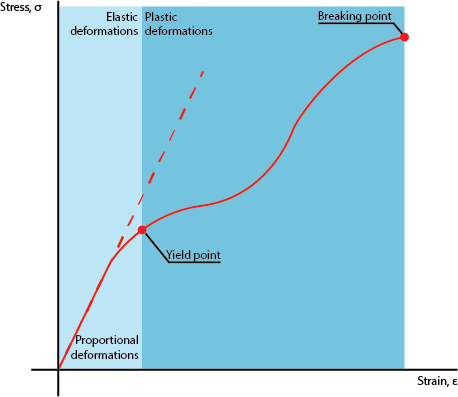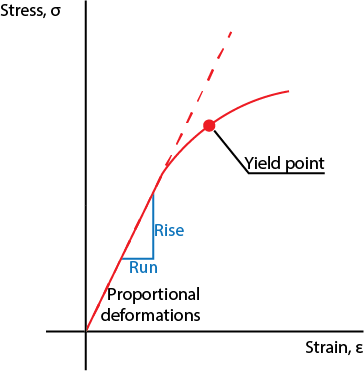Stretch Property Concept
Stretching is one of the material deformation types most relevant for fabrics. Stretching typically occurs during garment wearing, caused by forces applied by a human body. Tight fitting garments experience more stretching in comparison with loose fitting. The ability of fabric to stretch is based on the fabric composition; using elastic fibers such as Elastane causing higher stretchability. The fabric production method also affects the ability to stretch, e.g. looping method utilized for the knit fabrics production increases the stretchability of the fabric.

The application of various external stretching forces to a fabric causes appearance of Stress. Thiscould be described as a physical quantity that signifies the internal forces that neighboring particles of a continuous material exert on each other. Strain or elongation provide you with the measure of the deformation of the fabric caused by stress described above.
In simple words, applying a force to a fabric pieces causes appearance of the internal stress which results in a strain (fabric elongation).
Note:
The fabric behavior while stretching could be described utilizing a regular elastic theory. This theory was initially developed for construction materials with a homogeneous structure but is also applicable for non-homogeneous materials such as textiles.
According to the elastic theory, the fabric behavior while a load is applied could be described by the stress-strain curve, where the vertical axis provides you with the value of stress and horizontal axis provides you with the corresponding value of strain.

While a force is applied to a rectangular fabric specimen, the fabric is experiencing a stress (σ) defined as the ratio of the force (F) to the width of the specimen (W).

The strain (elongation, ε) is specified as a ratio of the difference between actual (in the stressed state, L) and initial specimen length (in the relaxed state, L0) to the initial specimen length:

The strain allows you to quantify the relative change of the specimen length that occurred in the result of applying certain force/load.
There are several stages in the stress-strain curve showing different fabric behaviors and referring to different deformation types.
-
Once the force is applied to the specimen and deformation starts, the stress-strain curve is linear. The linear segment of the curve refers to the stage of proportional deformation. When the load is continued, the stress-strain dependency then becomes non-linear.
-
The stage of elastic deformations (typically this stage includes the proportional deformations stage) refers to temporary deformations of the material observed only when the load is applied. Once the load is released, the fabric deformation disappears; initial fabric size is fully recovered.
-
The stage of plastic deformation refers to permanent irreversible deformation which stays even after removal of the applied forces.
The yield point symbolizes the end of elastic deformations as well as earmarking the beginning of plastic deformations.
In fashion and garment production world, typical loads naturally applied to fabrics during regular wearing are relatively low. This means that typical deformations experienced by the fabric belongs to the proportional deformation stage. The fabric behavior in this case obeys the general Hooke's law, and the slope (see the illustration below) is Young's modulus.

In this diagram:

Mathematically, considering formulas provided earlier to stress and strain, Young's modulus (E), can be calculated by dividing the stress (σ) by extensional strain (ε):

The Young’s modulus is a mechanical property that measures the stiffness of fabric; it’s ability to resist uniaxial deformation (stretching). More stretchable fabrics provide you with lower values of the Young’s modulus; higher values of the Young’s modulus represent more rigid fabrics.
Optitex utilizes the value of the Young’s modulus to describe the physical properties of the fabric. The Stretch and Shear properties historically used through Optitex products (equal to the Young’s modulus) describes the ability of the fabric to resist stretching. The Stretch property is defined to warp and weft directions; the Shear property describes the stretching resistance in the bias direction. These properties enable you to simulate the fabric behavior in the realistic manner while various forces are applied to different parts of the garment.
Both Stretch and Shear properties are measured using grf/cm units. Properties are defined within the range of 10-100,000 grf/cm. The lower value represents almost ideal stretchable fabric; the upper limit represents completely non-stretchable, rigid material.